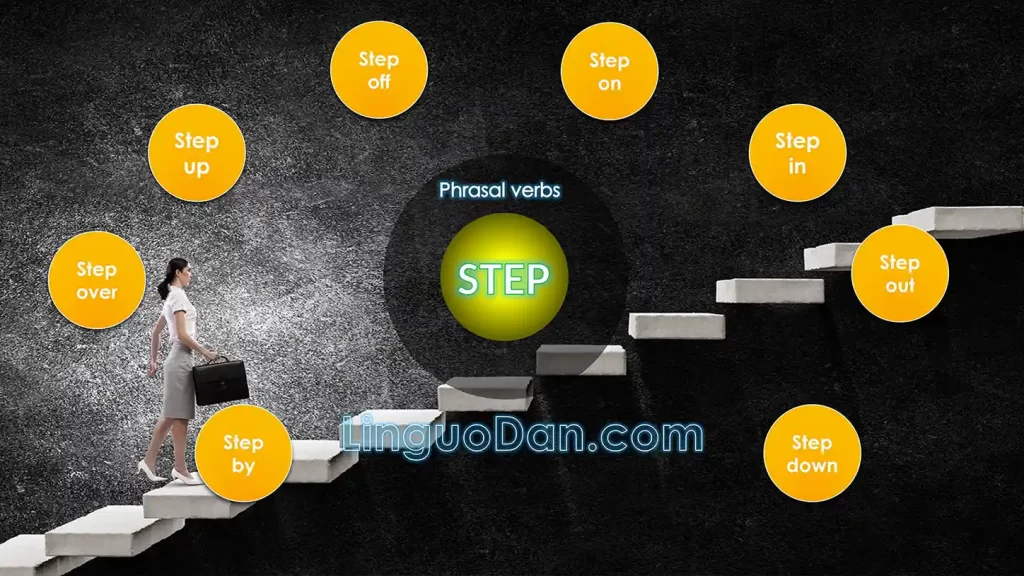Phrasal verbs with “Step” in English

Phrasal verbs step by step
Unravel the world of English language usage with our comprehensive guide on phrasal verbs with “step” [step]. Mastering these common expressions will elevate your English fluency and comprehension, making even the most complex situations accessible. A phrasal verb combines a main verb and one or more particles (prepositions or adverbs). Understanding “step” in the context of phrasal verbs requires focusing not only on the verb but the entire phrase.
TOP 20 phrasal verbs with “Step”
The verb “step” is a prime example of how phrasal verbs can transform the meaning of a basic word. Let’s take a closer look at some common “step” phrasal verbs and their meanings:
- Step in: To enter a situation or conversation to help or take control.
- Example: When the argument escalated, a teacher had to step in and mediate.
- Example: The government may have to step in to settle the disagreement between the union and the employers
- Step up: To increase one’s effort, take on more responsibility, or improve performance.
- Example: The team needed to step up their game to meet the project deadline.
- Example: Security measures were stepped up.
- Step down: To resign or reduce one’s position or involvement.
- Example: After years of leadership, she decided to step down as the committee chair.
- Example: Bob stepped aside to let me pass
- Example: I’ve spent so many years as chairman that I feel it’s time I stepped down.
- Step aside: To move to the side, often to allow someone else to pass or take charge.
- Example: The manager stepped aside to let the new employee handle the situation.
- Step out: To leave a place briefly or for a short time.
- Example: I’m going to step out for a moment to grab some fresh air.
- Example: He’s not in the office, he’s just stepped out for a breath of fresh air.
- Step off: To leave a platform, stage, or vehicle.
- Example: As the train arrived, passengers began to step off onto the platform.
- Step forward: To offer help, assistance, or information in a situation.
- Example: The volunteers stepped forward to lend a hand during the community event.
- Example: Several volunteers have kindly stepped forward.
- Step back: To move away from a situation or take a break to reevaluate.
- Example: He decided to step back and reconsider his career options.
- Step on: To put weight or pressure on something with your foot, often accidentally.
- Example: Be careful not to step on the fragile glass pieces.
- Step over: To cross over an obstacle or boundary by lifting your leg.
- Example: She gracefully stepped over the puddle to avoid getting her shoes wet.
- Step to: To approach someone or something, often in a confrontational manner.
- Example: He stepped to the opponent and demanded an explanation for the unfair play.
- Step through: To explain or demonstrate something step by step.
- Example: The instructor stepped through the process of setting up the software.
- Step around: To avoid a difficult topic or situation.
- Example: Instead of addressing the issue, he tried to step around it.
- Step by: To accomplish something gradually or in small increments.
- Example: She’s improving her painting skills step by step through practice.
- Step off on the wrong foot: To start a relationship or situation poorly.
- Example: Their awkward introduction made them start off on the wrong foot.
- Step on it: To hurry or accelerate, often while driving.
- Example: We’re running late; can you step on it and drive a bit faster?
- Step in line: To follow rules or conform to expectations.
- Example: Employees are expected to step in line with company policies.
- Step up to the plate: To take responsibility or face a challenge.
- Example: When the team needed a leader, she was ready to step up to the plate.
- Step into someone’s shoes: To understand another person’s perspective or experience.
- Example: After working in customer service, she truly stepped into the customers’ shoes.
- Step to the forefront: To become more visible or take a prominent role.
- Example: As the project progressed, his innovative ideas stepped to the forefront.
Remember that practicing these phrasal verbs in context will help solidify your understanding and usage of them in real-life situations.
Learning phrasal verbs, like those with “step,” might feel like deciphering a secret code. However, with dedication and practice, you can unravel their meanings and wield them with confidence. These linguistic gems add vibrancy and depth to your language skills, allowing you to express yourself more precisely in both spoken and written English. So take that step forward and embrace the fascinating world of phrasal verbs!